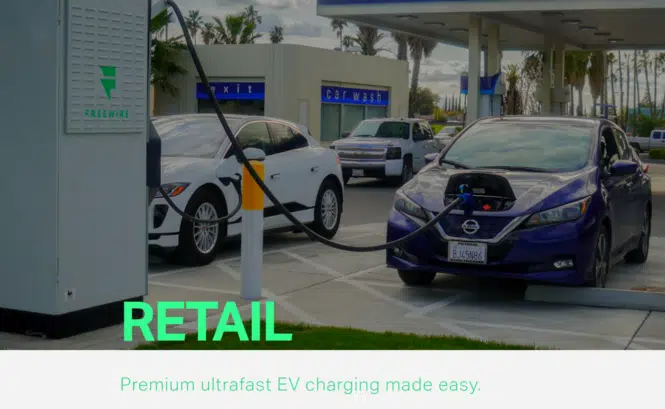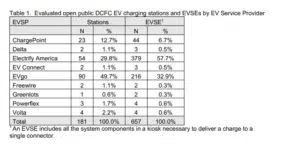
EV Station Failures
From BusinessInsider May 2022
Of the 657 open public DCFC CCS EVSEs evaluated in this study, 72.5% were functional at the time of testing while 27.5% were either not functional or the cable was too short to reach the EV inlet. The most common cause of a nonfunctional EVSE was an electrical systems failure which included an unresponsive or unavailable screen, a payment system failure, a charge initiation failure, a connection failure, or a broken connector.
In Brief
- As more and more EVs are adopted nationally, the need for fully functional and reliable open
public DCFCs will increase. - Non-functional public chargers pose an important equity issue as residents in rented or multi-family dwellings usually charge at public charging stations. In addition, non-functional public chargers will have a significant impact on drivers on road trips.
- High rates of non-functional chargers may inhibit the adoption of EVs. The design of location and quantity of needed DCFC charging stations, for the build out of a national EV charge infrastructure, should not have to assume that a quarter of the EVSEs will be nonfunctional.
- The level of system failure observed indicates a poor quality of electrical design, components, or software plus the need for EVSPs to improve their identification of the EVSE functional status to trigger timely service. In addition, effective compliance measures are needed for EV charging stations that are part of a court settlement or paid for with public funds.
- Compliance measures require clear definitions of reliability, uptime, downtime, and excluded time. It may be useful to consider reliability metrics from other industries (e.g., data centers, cloud service providers, etc.), such as mean time to recovery or mean time between failures,
etc. In addition, compliance measures may require third-party assessments of EVSEs, using a standard test methodology, at the time of initial operation and at regular intervals thereafter and an assessment of reliability data collected by the EVSPs.
Excerpt
As the global auto industry spends billions to go green, the number of electric-car charging stations in the US is growing rapidly. But quantity isn’t everything — and the quality of many of those stations is lacking.
A study of public electric-vehicle stations in California’s Bay Area found that only 72.5% of chargers were operational. California has by far the most electric car owners of any state and has been a leader in electric and hybrid vehicles for years. But its charging infrastructure shows major reliability issues, the study, first reported by the San Francisco Chronicle, found.
Methods (as described in actual report)
All open, public DCFC EV charging stations with EVSEs with CCS connectors in the 9 counties of the Greater Bay Area were identified using the NREL NFDC database and the PlugShare.com website. Stations with CCS connectors with a charge rate >= 50kW were identified. The 9 counties were Alameda, Contra Costa, Marin, Napa, San Mateo, Santa Clara, San Francisco, Solano, and Sonoma. Non-open EV charging stations, e.g., Tesla, as well as non-public EV charging stations, e.g., stations in paid parking lots, private workplaces, or business sites with restricted access hours, were excluded.
The identified EV charging stations were visited by a driver with an EV with a CCS charge inlet. Each EVSE at the station was tested by plugging the CCS connector into the EV and attempting to initiate and sustain a charge for 2 minutes. If the charge was successful, the EVSE was classified as functional. The unique kiosk and CCS connector number or name were recorded. If the parking space was occupied by another EV and the EV was charging, the EVSE was classified as functional. If the parking space was occupied by a non-EV or by an EV and not charging, it was classified as not tested. If none of payment methods tested worked, or the EVSE was not functioning, or did not initiate or sustain a charge, the EVSE was classified as nonfunctional. If the cable was too short to reach the EV charge inlet, the EVSE was classified as a design failure.
The payment methods tested included 2 different functioning credit cards and the vendor mobile app or membership card. Payment methods were tested in the following order, credit card 1 insert, credit card 1 swipe, credit card 2 insert, credit card 2 swipe, then mobile app or membership card, until one of the payment methods was accepted. Each method, i.e, a swipe, was attempted twice before moving to the next payment method. The credit cards used for testing were Mastercard, Visa, and Amex. If any of the payment methods worked and led to a 2 minute charge, the EVSE was classified as functional. The EV drivers were instructed not to call the service number if the EVSE did not work; a functioning EVSE should not require a call to a service number.
Twenty volunteer EV drivers assisted in the testing of the EV charging stations. Only EVs with CCS charge inlets were used. The vehicles used for testing were the Chevy Bolt, Kia Niro,Hyundai Kona, Ford Mustang Mach E, and Porsche Taycan. The EV battery charge level was Electronic copy available at: https://ssrn.com/abstract=4077554
Reliability of EV Direct Current Fast Chargers
5 less than full at the time of testing. The volunteers were trained on the study methods and assigned EV charge stations to test. The survey was completed using a Qualtrics survey on a mobile device while the driver was at the charging station.
A random sample of 10% of the stations was tested at two points in time, approximately 1 week apart, to determine whether the functional state of the EVSEs changed over time.
More Posts


